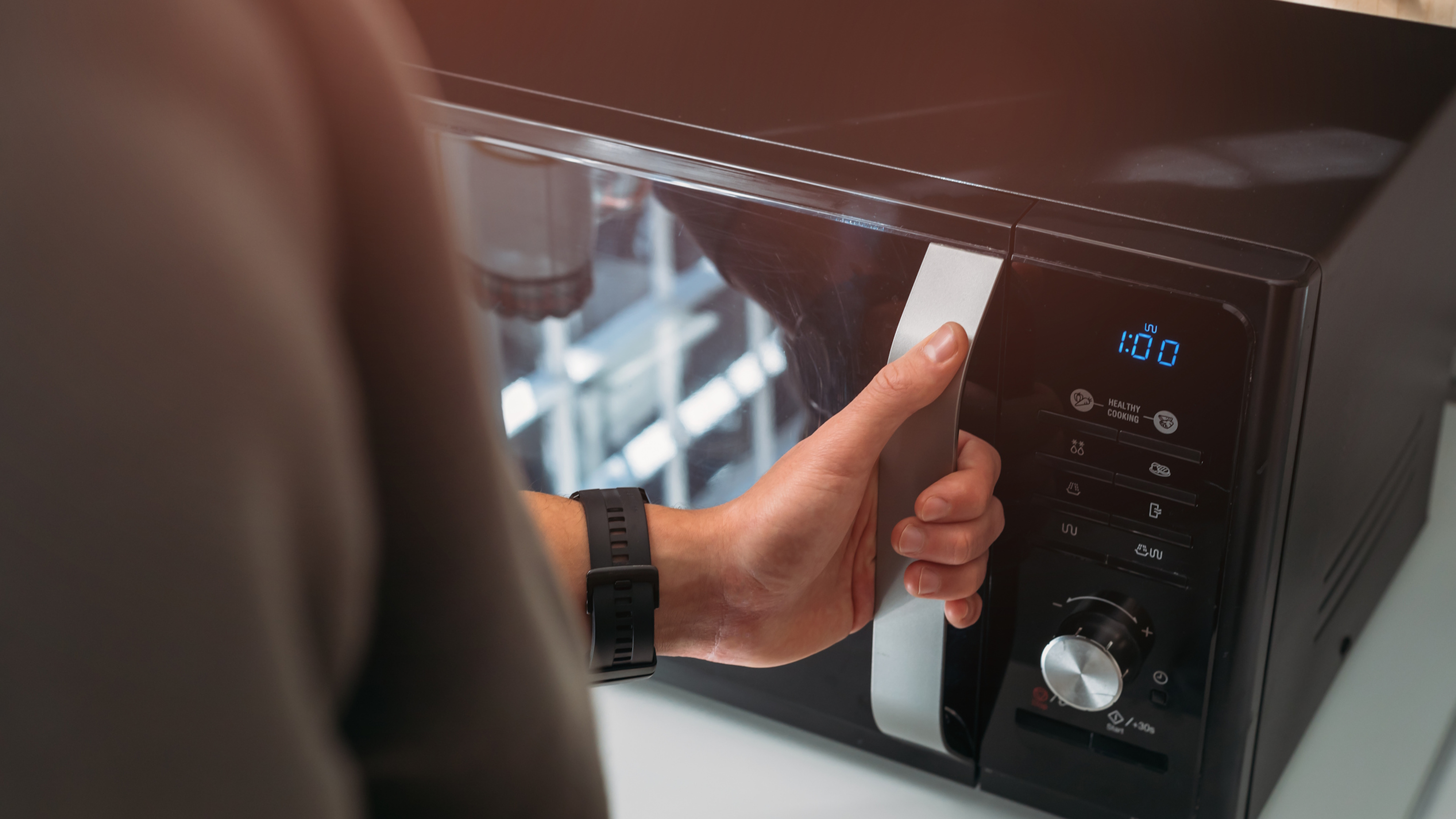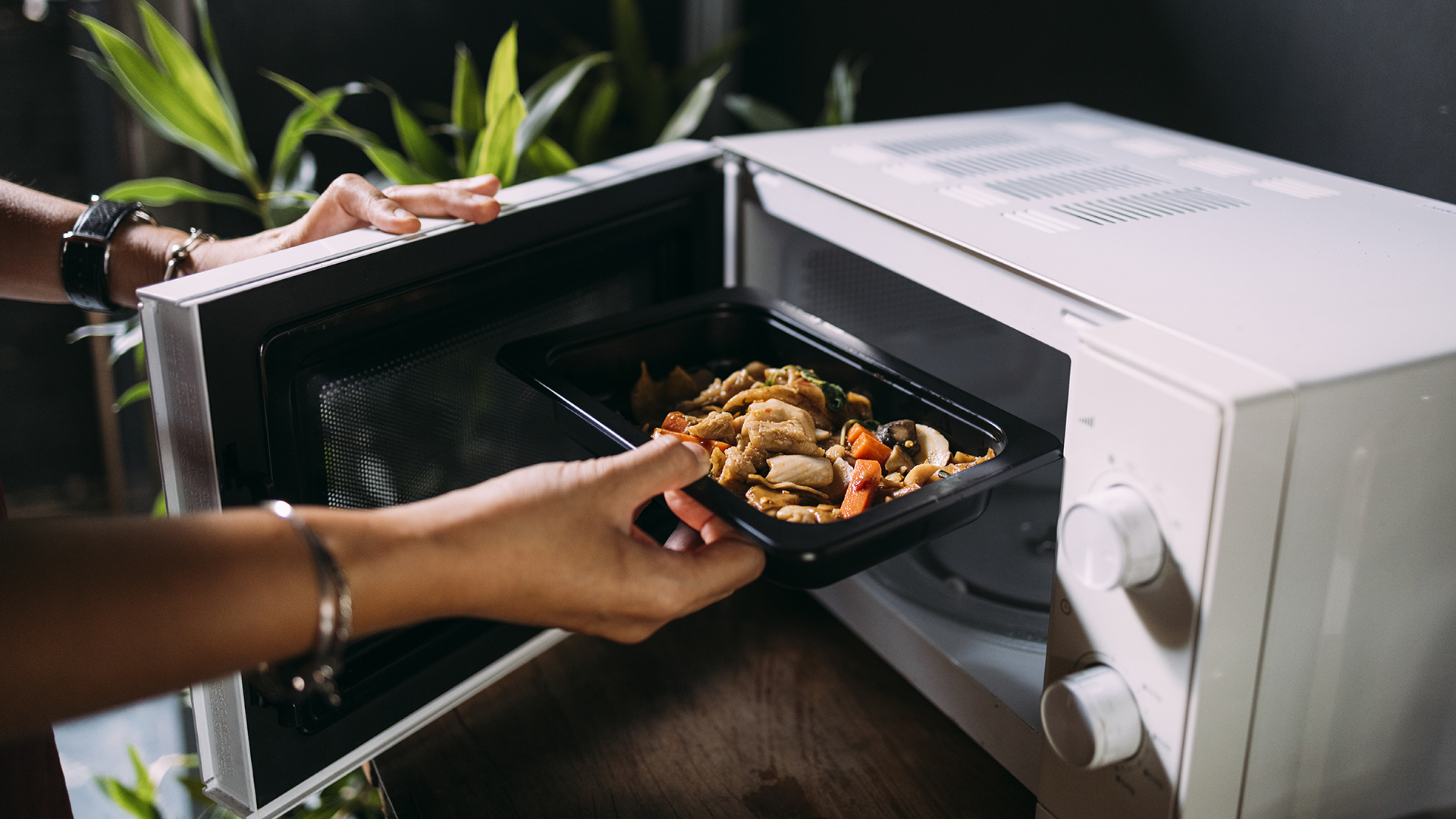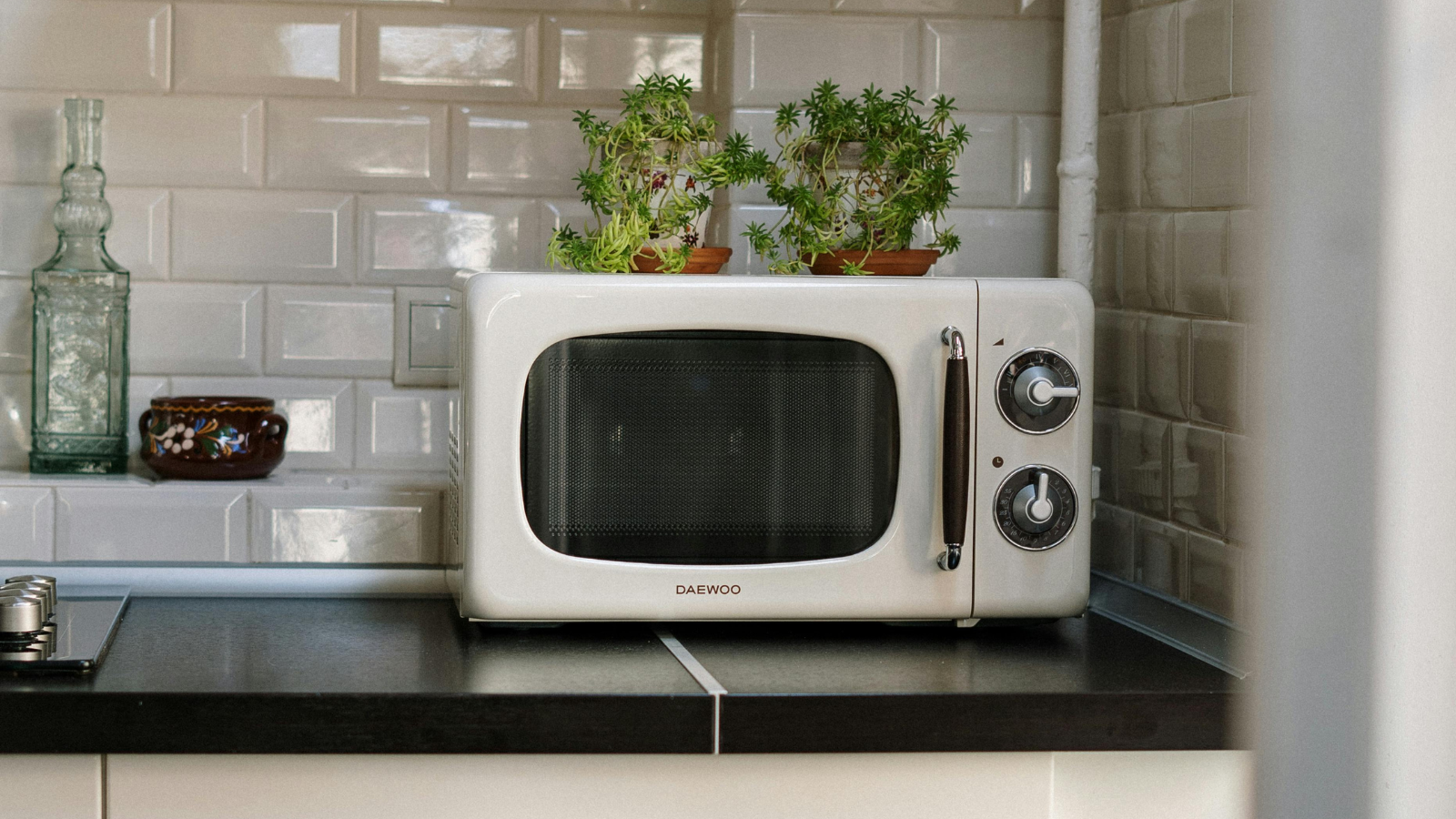How to choose a microwave—which type is best for your kitchen?
These time-saving kitchen tools allow you to cook delicious meals from scratch and reheat food in minutes.

Microwaves might have a lazy, ready-meal reputation, but these days, they’re far more versatile than that, with many models now offering air frying, convection, and steam cooking modes.
It doesn’t matter if you’re heating up last night’s supper or cooking gourmet meals from scratch. Having one in your kitchen can be a true godsend. In this article, we’ll help you choose the perfect one for your home, so regardless of whether you’re looking to upgrade a broken appliance or add one of the best microwaves to your kitchen, we’ve got you covered.
How to choose a microwave
With so many appliances on the market, it can be hard to decide what size, power, and type of microwave is best for you, so read on. We’ll explain the pros and cons of all the different types of microwaves, ranging from countertop models to premium over-the-range installations, and give you a breakdown of all the features and specifications to consider before you finally click the buy button.
What types of microwave are there?
Countertop
If you have lots of countertop space, these are a no-brainer. You can pick from a wide range of models, from the best compact microwaves to large, high-capacity combi-microwaves with built-in convection, air frying, and steam cooking modes. The only limits here are your budget and the size of your countertop.
If you’d rather not spend money on getting a built-in or over-the-range model professionally installed, you can also simply put a countertop model on a shelf or in a pantry—or even a drawer or cupboard, if it’s big enough. However, you’ll always need to ensure it’s installed safely, as it can be heavy and require ample ventilation for safe operation.
Size and looks are the downsides here. Even if you have lots of countertop space, you’ll have much less after you’ve put a microwave on the counter, and you’ll also need to leave enough space around the microwave to provide safe ventilation.
Looks may be a sticking point, too. If you want an appliance that complements your kitchen, you may have to pay a premium for a more stylish high-end model – or opt for a built-in or over-the-range model instead. After all, it’s only so attractive you can make a big rectangular metal box.

Built-in
If you hate the idea of your precious countertop space being taken up by a hulking great appliance, a built-in microwave can be a great pick. These come in a range of sizes to fit the standard cabinet widths of 24, 27, or 30 inches and different heights depending on their capacity. They can also be installed in wall cavities or underneath your countertop if space is limited.
The bigger, more powerful models often come with combi cooking features such as air frying, steam, and convection cooking, too, so you don’t need to compromise on cooking speed, features, or capacity.
Unless you’re super handy around the home, you’ll need to pay someone to install a built-in model. Some stores may offer an installation service, but this won’t always be the cheapest option, so you may want to search online for a local handyman service.
If the DIY route tempts you, replacing a broken appliance with a like-for-like option may be relatively straightforward. However, upgrading an existing built-in model to a bigger, larger capacity will require you to check for enough space. Bigger capacity models can be wider and taller, so you’ll need to double-check that a model will fit in your kitchen and employ a professional to cut down your cabinetry if necessary.
Over-the-range
As the name suggests, these are installed above your stove. Unlike other types of microwaves, over-the-range appliances combine a microwave with a range hood. This means you get a ventilation system into the bargain to rid your kitchen of steam, smoke, and cooking odors.
These are also available in low-profile and space-saving designs, which can help minimize the amount of cabinet space they take up. Just like the other types of microwave, combination appliances add air frying, steam, and convection cooking modes to boost their versatility in the kitchen.
Unless you’re very handy at DIY, this is a job to leave to the professionals. You’ll need ducting and vents installed to blow all the steam and cooking odors outside and both electrical and kitchen installation expertise to make for a clean installation in your existing cabinetry, too.
Whether you choose a store installation or employ the skills of your local handyman, you’ll want to double-check and triple-check that there’s space in your kitchen for your chosen appliance, too, as they come in a wide range of shapes and sizes.
It’s worth noting that over-the-range models generally aren’t as effective as a range hood when it comes to ventilating your kitchen, though, so it’s always worth considering if a separate range hood and a built-in microwave will be a better fit for your kitchen.

What size of microwave do I need?
When shopping for microwaves, you’ll often see them advertised in different sizes. Manufacturers may refer to models as compact, mid-size/standard, or full-size/large appliances.
The measured dimensions and cooking capacity will vary from model to model. Still, it’s worth noting that combi-microwaves may sacrifice cooking capacity to squeeze in extra components such as heating elements and steam functions.
David Rees, appliances expert and director of HomeSupply, said: "15 to 20 liters is often the standard microwave capacity and is best for households with two to four people. Due to size, microwaves of this capacity tend to be solo microwaves.
"Grill and combination microwaves often have a capacity of at least 21 to 30 liters, as the added capacity means they can be used for larger foods and more complex tasks. Many flatbed microwaves will have a capacity within the 25 to 30-litre range."
Sign up to receive the latest news, reviews, buying guides and deals direct to your inbox

David Rees has worked as the director of HomeSupply for almost twenty years. He is passionate about home improvement and prides himself on connecting customers with the best brands.
If you’re buying a countertop model, make sure to measure the space it will take up on your countertop and also allow enough space around it to provide safe ventilation—most manufacturers recommend leaving at least 1 inch of space at the rear of an appliance and 3 inches or more around the sides.
You’ll also need to check the dimensions for built-in and over-the-range models. It is essential to buy an appliance designed to complement your existing cabinetry and kitchen design.
However, just because space is limited in your kitchen doesn’t mean you can’t accommodate a larger microwave – after all, you can replace some of your existing appliances with a single combi-microwave. These models combine multiple cooking modes, such as convection oven cooking, steam cooking, and air frying, so you don’t need several appliances cluttering your countertop or taking up precious space in your cabinets.
What features should you look out for?
Power
Microwaves with a higher power rating will, in theory, cook faster than lower-rated appliances. That doesn’t mean all appliances are built equal—we’ve seen some big differences in cooking performance between similarly rated appliances—but it’s a good indicator.
David Miloshev, appliance technician for Fantastic Services, told us: "Assess the power wattage of the microwave model you want to buy. When you do that, remember that higher-wattage models generally provide faster cooking and need less time. A microwave with power wattage between 800 and 1200 watts for standard household use will be the most suitable."
Basic compact models start around 600W, while the most powerful consumer models can reach as high as 1,200W. If you double the wattage, you halve the cooking time, so a 600W microwave will require cooking times that are twice as long as a 1,200W appliance.
Commercial models can reach over 3,000W, but they require dedicated 230V mains supplies; by contrast, the 120V 15A power outlets found in most US homes can only safely power appliances up to a limit of around 1,800W.

David Miloshev has been an appliance technician and certified electrician at Fantastic Services for over five years. His comprehensive training and profound understanding of appliance technology make him an invaluable asset to the team. In addition to his technical expertise, David is known for his exceptional customer service. He always finds a way to explain complex issues in a manner that instills confidence in his clients.
Cooking capacity
As mentioned, you can choose from various microwave sizes, providing anything from half a cubic foot to well over 2 cubic feet of cooking capacity. A compact model may be enough for a small apartment or occasional use, but larger families will likely need to super-size their appliances. Moreover, you’ll struggle to get larger cooking dishes and casseroles into all but the biggest microwaves. Hence, it’s worth checking each model’s cooking capacity to ensure it’s big enough for you.
David Rees said, "Depending on the amount of space available in your kitchen, there are compact models that can be placed on top of worktops or built-in models to match fitted kitchens.
"You should also evaluate the door size of the microwave, as this will affect how easy it is to remove hot food from within the appliance. You will also need to consider the clearance space the microwave will need, which is the space required above and behind the appliance for sufficient ventilation. This is usually at least 15cm, but is particularly important if you have a combination microwave as they can expel a lot of air with certain functions."
Presets
While basic models have nothing more than a timer, more upmarket appliances add preset cooking modes for specific food types – such as baked potatoes, pizza, or different types of meat. Other models add shortcut buttons for specific cooking times, such as 60 seconds or several minutes so that you can start the cooking process with a single button press.

Cooking modes
More expensive appliances often add convection, air frying, and steam cooking modes to the standard microwave cooking. Moreover, these models can often combine multiple cooking methods to cook a wider variety of dishes and reduce cooking times without compromising quality.
"Look through the microwave model’s available features, such as sensor cooking, convection functions, and preset programs," David Miloshev said. "This will help you simplify your meal preparation.
"Solo microwaves usually include features such as re-heating food, making milk, tea, and coffee, cooking rice, noodles, and pasta, making popcorn, and defrosting. Grill microwaves have all these features except popcorn, plus features for making pizza and toasting. Convection ovens offer all these features, plus features for making brownies, cakes, and bread."
Safety features
Buying Guides
Best microwaves: speedy, convenient, and energy-efficient appliances, tried and tested
Reviews
LG MSER0990S 0.9 Cu. Ft. Countertop Microwave review: a large appliance with plenty of cooking room
Cuisinart CMW-70 0.7 Cu. Ft. Microwave review: a solid microwave with multiple customization options
LG LMC2075ST 2.0 cu. ft. NeoChef Countertop Microwave review
Breville BMO870BSS1BUC1 Combi Wave Microwave review: a versatile oven for clutter-free kitchens
Safety is paramount in any kitchen, so appliances with child locks add peace of mind. These are especially important for countertop or built-in models, which are sometimes installed below countertop height—anywhere a microwave’s controls are within reach of curious little fingers.
Sensor cooking
There’s nothing worse than overcooking your food, so more upmarket microwave appliances often add sensor cooking features to their specifications. These appliances use steam sensors to detect when items are losing too much moisture, which might indicate that the food is drying out or at risk of burning. This means you can simply activate the sensor cooking mode for the food you’re cooking and relax, knowing that the microwave will automatically stop the cooking process once it’s cooked thoroughly.
Mute function
Not everyone appreciates their appliances beeping aggressively after every use, so it's worth checking whether your prospective appliance allows you to disable audible alerts completely. After all, if you love nothing better than treating yourself to a quickly reheated midnight snack, you might prefer it if your microwave doesn’t alert everyone in the home to your secret snacking with a loud alarm.

When choosing a microwave for your kitchen, consider things like space, installation, and cooking needs. Countertop microwaves offer versatility and easy installation but may take up valuable space, while built-in microwaves provide a sleek look but may require professional installation. Over-the-range models combine microwave and ventilation functions but may be challenging to install.
Think about your kitchen layout before selecting a microwave type. Also, consider the microwave size in relation to your cooking needs. Larger capacities are suitable for family use, while smaller ones are ideal for individuals or couples.
You should also think about power, cooking capacity, presets, cooking modes, safety features, sensor cooking, and other functions you may need. Higher power cooks faster, while safety features like child locks add peace of mind. Sensor cooking prevents overcooking, and a mute function reduces noise.
